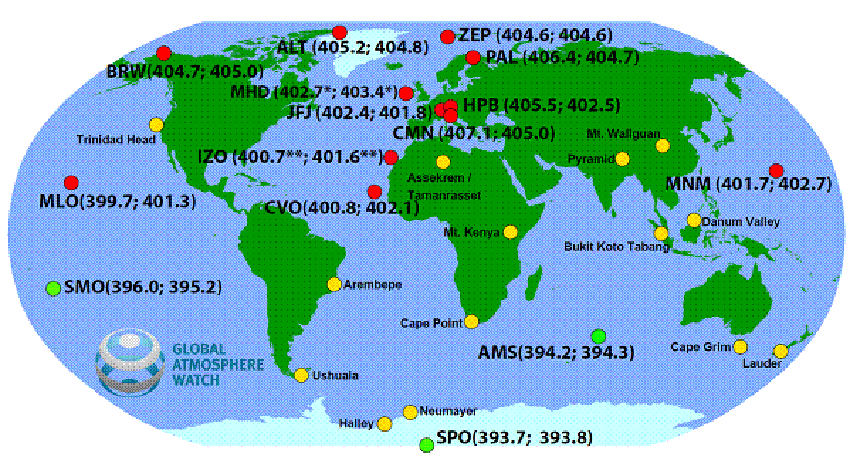Seeing red: North’s CO2 hits new peak
Global values met or exceeded 400 parts per million in air

Dots mark CO2-monitoring stations reporting to WMO. The values in parentheses are April’s average CO2 levels.
Global Atmosphere Watch/WMO
By Beth Mole
April 2014 was the first month in recorded history where average carbon-dioxide levels across the northern half of the world measured at least 400 parts per million (ppm) in air. A United Nations agency reported the new record on May 26.
High above Earth’s surface, carbon dioxide acts as what physicists call a greenhouse gas. The term gets its name from the fact that like the window on a greenhouse, this gas allows sunlight to pass through to the lower atmosphere and ground, where it heats things up. All of that heat, which radiates in the form of infrared energy, would then bounce back into space — except that greenhouse gases trap much of it near to Earth’s surface. This helps keep the planet from being freezing cold, year-round. But there can be too much of a good thing. And the growing excess of carbon dioxide has led to a slowly growing fever, what scientists call global warming.
Climate scientists first recorded the troubling high in carbon dioxide in the Arctic in 2012. Then Hawaii registered a similar peak last year. But until now, the rest of the globe had yet to consistently hit the high mark, notes the United Nation’s World Meteorological Organization, or WMO. The 400 ppm level is largely symbolic. Nothing magic happens at that value. It simple represents a troubling milestone. This CO2 value is nearly 50 percent higher than before the Industrial Revolution, almost two centuries ago. More importantly, the WMO points out, the planet has not seen CO2 levels this high in more than 800,000 years.
And scientists expect CO2 levels to continue rising. One reason: Once a molecule of this gas makes it high into the atmosphere, it will remain there for an average of 100 years. Many other greenhouse gases, by contrast, have far shorter lifetimes. They tend to persist only days to perhaps as long as 12 years.
As such, the Northern Hemisphere’s month-long record CO2 high should sound an alarm about addressing emissions, the WMO contends. From 2002 to 2012, it notes, CO2 was responsible for 85 percent of the total increase in the atmosphere’s heat-trapping ability.
“If we are to preserve our planet for future generations, we need urgent action to curb new emissions of these heat trapping gases,” said WMO Secretary-General Michel Jarraud. “Time is running out.”
Researchers now expect that within a year or two, the entire globe will experience CO2 levels averaging 400 ppm or higher.
Power Words
carbon dioxide A gas produced by all animals when the oxygen they inhale reacts with the carbon-rich foods that they’ve eaten. This colorless, odorless gas also is released when organic matter (including fossil fuels like oil or gas) is burned. Carbon dioxide acts as a greenhouse gas, trapping heat in Earth’s atmosphere. Plants convert carbon dioxide into oxygen during photosynthesis, the process they use to make their own food.
climate change Long-term, significant change in the climate of Earth. It can happen naturally or in response to human activities, including the burning of fossil fuels and clearing of forests.
greenhouse gas A gas that contributes to the greenhouse effect by absorbing heat. Carbon dioxide is one example of a greenhouse gas.
Industrial Revolution A period of time in the early 1800s marked by new manufacturing processes and a switch from wood to coal and other fossil fuels as a main source of energy.
World Meteorological Organization Created in 1950, this is a special agency of the United Nations. More than 190 nations and territories belong to WMO, which serves as the official “voice” on the status of the planet’s atmosphere and how it is behaving. WMO is based in Geneva, Switzerland.







